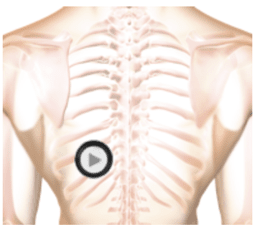Fundamentals of Lung Sounds
Auscultation
Auscultation of the lungs is an essential part of physical examinations. All fields of the chest wall should be examined, including the chest wall anterior, posterior and flanks.
This website provides a wide range of auscultation courses, reference guides, and quizzes. Each mini-course consists of lessons with text, a lung sound recording, and a dynamic waveform animation. Certificates of achievement are available.
Lung Auscultation Locations
Auscultation of lungs sounds should be conducted over the anterior and posterior chest walls. See the associated illustration for these locations. Many stethoscopes have chestpieces with both bell and diaphragm. Typically, start with the diaphragm but switch to the bell to hear lower-pitched sounds.
Timing and Duration
During auscultation, make a note of the sound's timing within the respiratory cycle. Your notes may include inspiratory, expiratory or more specific terms such as early expiratory.
Pitch
A lung sound's pitch (frequency) is an important characteristic. The observer should classify the sound or murmur's pitch as low, medium, or high. The stethoscope's bell can be helpful with low-pitched sounds, while the diaphragm should be used for medium or high-pitched sounds.
Using Our Auscultation Lessons
Here we provide an example of lung sounds, a fine crackle.
Playback
Click the playback button on the torso to hear a short recording.


The patient was seated during auscultation.
Waveform
A waveform is a plot of the lung sound's amplitude over time. Click the play button to view this waveform and hear the corresponding lung sound. This video will loop until paused.
Start Fundamentals of Lung Sounds Course
Fundamental Lung Sounds
Introduction
We have selected eight important lung sounds for this introductory auscultation course. Each lesson, described below, includes a textual description, audio recording, and a waveform video. Optionally, a quiz can be taken to measure comprehension and listening skills.
Vesicular Lung Sounds
Vesicular lung sounds are the most common auscultated sounds, usually heard over most of the chest wall. These sounds are of low to moderate sound intensity (volume) with a low-pitch (200-600 Hz) with a rustling quality. During expiration, the sound intensity can diminish somewhat. The inspiration to expiration (I:E) ratio is typically 3 to 1.
Vesicular Lung Sounds - Lesson, Audio, Waveform
Bronchial Breath Sounds
Bronchial breath sounds are hollow, tubular sounds that are higher-pitched compared to vesicular sounds. They can be auscultated over the trachea and anteriorly along each side of the sternum, from the second to fourth intercostal spaces. Posteriorly, along the vertebral column from the third to sixth intercostal spaces.
The stethoscope's diaphragm should be used for these breath sounds. There is a distinct pause in the sound between inspiration and expiration. I:E ratio is 1:3.
Bronchial Breath Sounds - Lesson, Audio, Waveform
Wheeze
Air flowing through a narrowed bronchus produces wheezes. Accordingly, these sounds will have their highest sound intensity when auscultating over or near the central airways.
Wheezes are adventitious lung sounds associated with secretions, obstructions, tumors, or airway compression. They are continuous sounds with a musical quality. High-pitched wheezes have a squeaking quality, while low-pitched wheezes are similar to snoring or moaning. The proportion of the respiratory cycle occupied by the wheeze roughly corresponds to the degree of airway obstruction.
Wheezes are also classified by when they appear in the respiratory cycle, e.g. inspiratory wheezing or a late expiratory wheeze, and by additional information about the sound quality (monophonic or polyphonic). These characteristics can be found in our Intermediate Lung Sounds module.
Wheeze - Lesson, Audio, Waveform
Rhonchi
Rhonchi are continuous and low-pitched adventitious lung sounds caused by fluids or secretions in the large airways. They often have a snoring, gurgling, or rattle-like quality. They are heard primarily during expiration, but in some patients, rhonchi will also appear during inspiration. Rhonchi will usually clear or alter in sound after coughing.
Rhonchi - Lesson, Audio, Waveform
Fine Crackles
Fine crackles are brief, discontinuous, popping, high-pitched breath sounds. These sounds are also similar to the sound of Velcro fasteners being pulled apart or cellophane being crumpled. Crackles can appear throughout the respiratory cycle.
Fine Crackles - Lesson, Audio, Waveform
Coarse Crackles
Coarse crackles are discontinuous, popping, or bubbling breath sounds. They are louder, lower in pitch, and of longer duration than fine crackles.
Coarse Crackles - Lesson, Audio, Waveform
Pleural Rubs
Pleural rubs are creaking or grating sounds. The sound is similar to leather against leather or walking on fresh snow on a cold day. Coughing will not alter the sound.
Pleural rubs are generated when two inflamed surfaces are sliding by one another, such as in pleurisy. During auscultation, pleural rubs can be localized to a specific point on the chest wall. These sounds occur with movement of the patient's chest and will stop when the patient holds her breath. They appear on inspiration and expiration. Should the sound continue when the patient holds her breath, it may be a pericardial friction rub.
Pleural Rubs - Lesson, Audio, Waveform
Stridor
Stridor is created by air flowing through an upper airway that is narrowed or obstructed. It occurs in 10-20% of extubated patients. Stridor is a loud, high-pitched crowing breath sound heard during inspiration. Stridor may also occur throughout the respiratory cycle, particularly if the condition worsens. Often it can be heard without a stethoscope. Causes of stridor are obstructions, pertussis, croup, epiglottis, aspirations.
Stridor - Lesson, Audio, Waveform
Additional Learning Resources
Lung Sounds Reference Guide
This auscultation reference guide includes over twenty adventitious and normal breath sounds. The guide also includes listening tips and waveforms with a moving cursor.
Breath Sounds GuideLung Sounds Intermediate Course
After mastering the fundamentals of lung sounds, this intermediate course trains users on advanced forms of wheezes and crackles and introduces voiced sounds (bronchophony, egophony, whispered pectoriloquy).
Intermediate Lung SoundsAuscultation Repetition Training
For some learners, auscultation repetition training is a useful complement to our courses. The repetition training modules include audio and a dynamic lung sound waveform for helping users learn each breath sound.
Repetition TrainingPulmonary Problem-Solving
We provide two courses, each with eight cases in pulmonary problem-solving that integrate clinical skills training with respiratory care. These cases require knowledge, reasoning and patient assessment skills.
Pulmonary ProblemsCourse Quiz
After completing all lessons in a course, a quiz becomes available. If the user successfully completes a quiz, results are saved to the user's dashboard and a certificate can be printed.
Reference Guide
A comprehensive heart sounds and murmurs reference guide. For each abnormality, one or more sound recordings are available along with text, phonocardiogram and cardiac animation.Other Resources
Authors and Reviewers
-
Heart sounds by Dr. Jonathan Keroes, MD and David Lieberman, Developer, Virtual Cardiac Patient.
- Lung sounds by Diane Wrigley, PA
- Respiratory cases: William French
-
David Lieberman, Audio Engineering
-
Heart sounds mentorship by W. Proctor Harvey, MD
- Special thanks for the medical mentorship of Dr. Raymond Murphy
- Reviewed by Dr. Barbara Erickson, PhD, RN, CCRN.
-
Last Update: 11/10/2021
Sources
-
Heart and Lung Sounds Reference Library
Diane S. Wrigley
Publisher: PESI -
Impact Patient Care: Key Physical Assessment Strategies and the Underlying Pathophysiology
Diane S Wrigley & Rosale Lobo - Practical Clinical Skills: Lung Sounds
- Essential Lung Sounds
Diane S. Wrigley, PA-C
Published by MedEdu LLC - PESI Faculty - Diane S Wrigley
-
Case Profiles in Respiratory Care 3rd Ed, 2019
William A.French
Published by Delmar Cengage - Essential Lung Sounds
by William A. French
Published by Cengage Learning, 2011 - Understanding Lung Sounds
Steven Lehrer, MD
- Clinical Heart Disease
W Proctor Harvey, MD
Clinical Heart Disease
Laennec Publishing; 1st edition (January 1, 2009) -
Heart and Lung Sounds Reference Guide
PracticalClinicalSkills.com